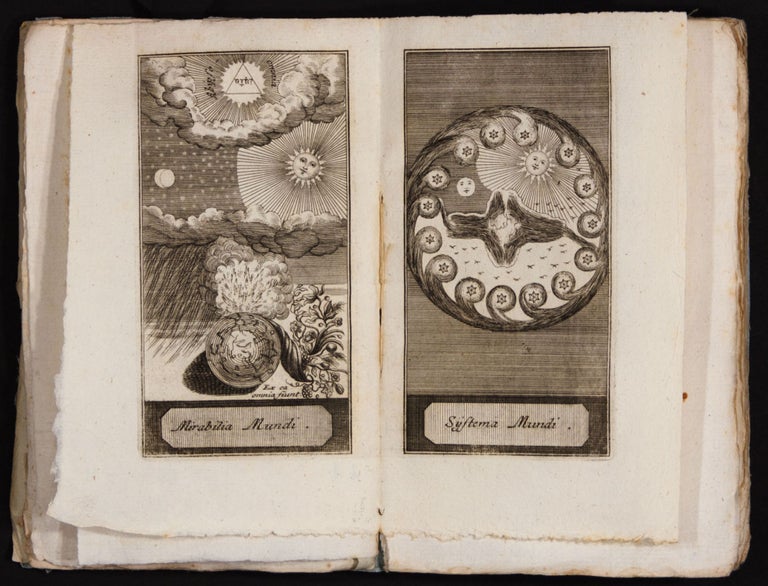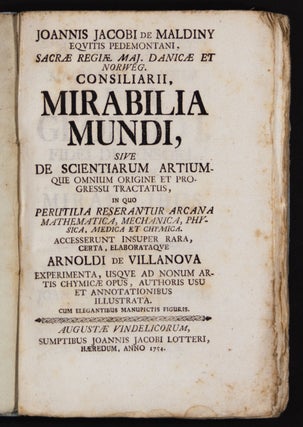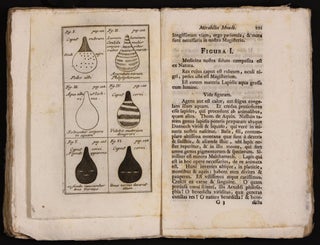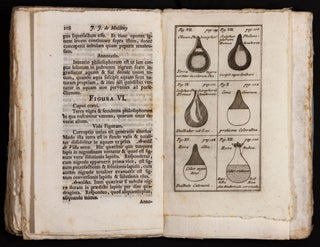Mirabilia Mundi, sive de scientiarum artiumque omnium origine et progressu tractatus.
8vo [18.8 x 12.5 cm], (6) ff., 135 pp., (5) pp., with (4) ff. full-page engravings, and with woodcut headpieces and tailpieces. Bound in contemporary blue paper wrappers. Only very minor wear to binding. Unopened and uncut, only the occasional very minor stain. Rare first octavo edition of this unusual illustrated compendium of alchemy and arcana, here in a pristine, unopened and uncut example. The Mirabilia Mundi, apparently the only work by the Piedmontese writer Joannes Jacobus de Maldiny, is a brisk primer of secret knowledge published during alchemy’s ‘last stand’ against the rise of modern chemistry in the 18th century. Maldiny signals in his preface an awareness that his taxonomies have recently come under attack by new methods, (and he indicates a familiarity with the research of Robert Boyle (1627-91), the founder of modern chemical practice [p. 28]), but he defends old hermetic methods as still of much use to the fields of botany, zoology and medicine. The final 3 chapters (of 12) of the Mirabilia Mundi form the bulk of the work and are dedicated to aspects of experimental chemistry/alchemy, treating the material requirements of the laboratory (furnaces, vessels, etc.), how to work with solutions and acids, the nature of combustion, and so forth. Maldiny here reserves a special reverence for the work of the physician Arnoldus de Villa Nova (1240-1311) and claims to draw much of his material from an illustrated Arnoldus manuscript in his possession (“with elegant hand-drawn images”) which he believes to be unedited (pp. 98-9 and title page). Maldiny reproduces Arnoldus’s drawings of the 12 substances (each in a glass vessel) required to outfit a perfect lab and adds Arnoldus’s ‘annotations’ to his own extensive discussion of each substance. Further select anecdotes of various arcana are taken from Maldiny’s “extensive labor and experimentation” (p. 120). The first 9 of the work’s 12 chapters – which open with 2 fine engravings of the ‘Wonder of the World’ (God, the heavens, the four elements) and the ‘World System’ (geocentric) – survey the theological underpinnings of hermetic knowledge, mathematics (arithmetic, geometry, architecture, mechanics), astronomy (with 4 astrological tables aligning stones, animals, plants, colors, metals, human traits, body parts, and ‘aromatics’; a mention of telescopes), experiments concerning light air, fire, water, fluids, and oils (with some mention of optics and art and recent the), earthly solids (stones, salts, sulfur), plants and their ‘virtues’ (with extensive lists arranged by traits), animals and fish (a compendium of fauna). A chapter on the human physiology, diseases and pharmacology discusses everything from the number of bones in the body to behavioral traits of the world’s races, and provides secret cures for problems ranging from plague, to paralysis, to poisoning (excepting one ailment: “Death: There’s no medicine in the garden against the power of death”). Maldiny’s Mirabilia Mundi first appeared in a duodecimo format in Braunschweig in 1725, and a second edition quickly appeared in 1726. It is intriguing that, against the tide of an ever-increasing division between ‘old’ alchemy and modern chemistry, the work was still deemed of use when the present octavo (3rd) edition appeared almost three decades later, in 1754. OCLC records no U.S. examples of either the present 1754 edition or the 1725 first; the 1726 edition is recorded at Yale, Wisconsin and Penn. * J. Ferguson, Bibliotheca Chemica, p. 67; J. Ferguson, Bibliographical Notes on Histories of Inventions and Books of Secrets, p. 24; W. R. Newman and L. M. Principe, Alchemy Tried in Fire.
Sold





